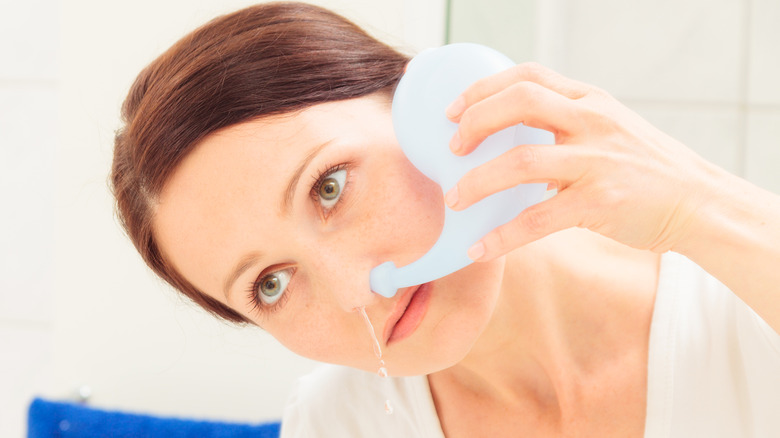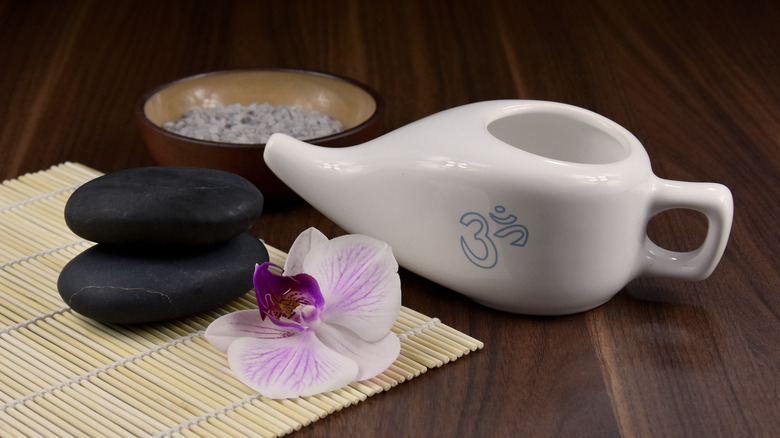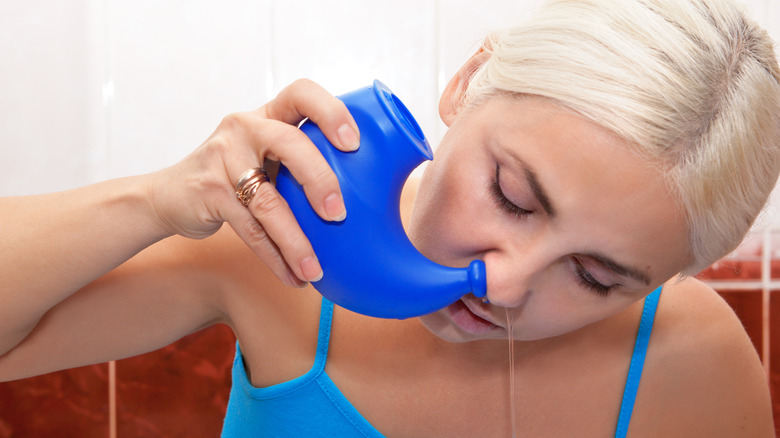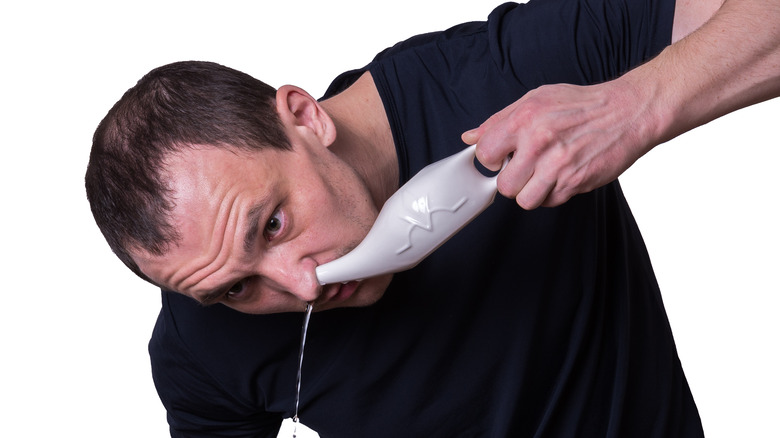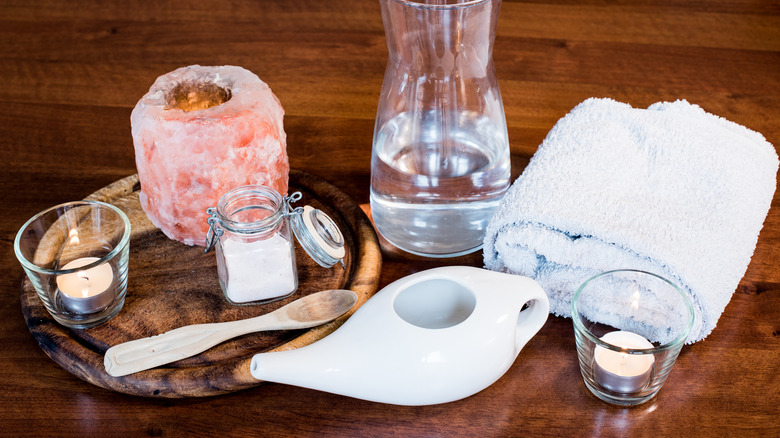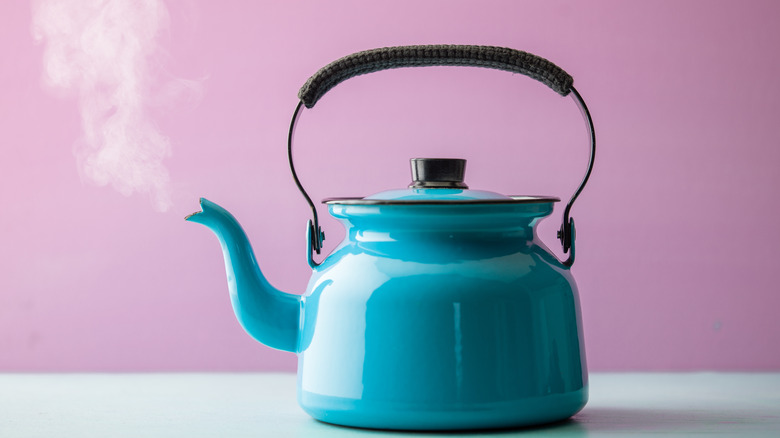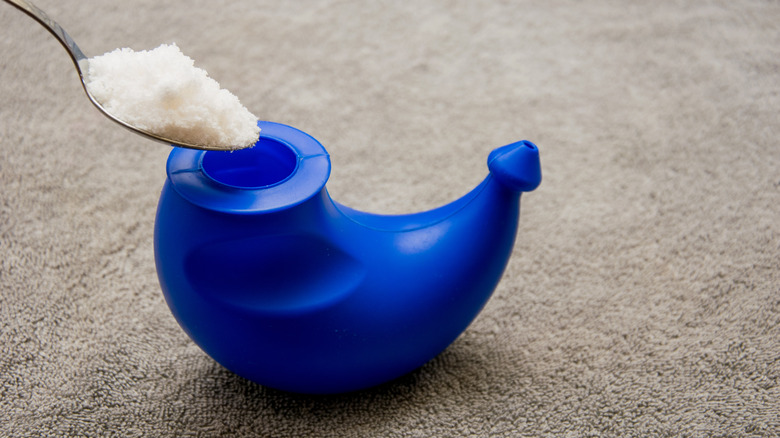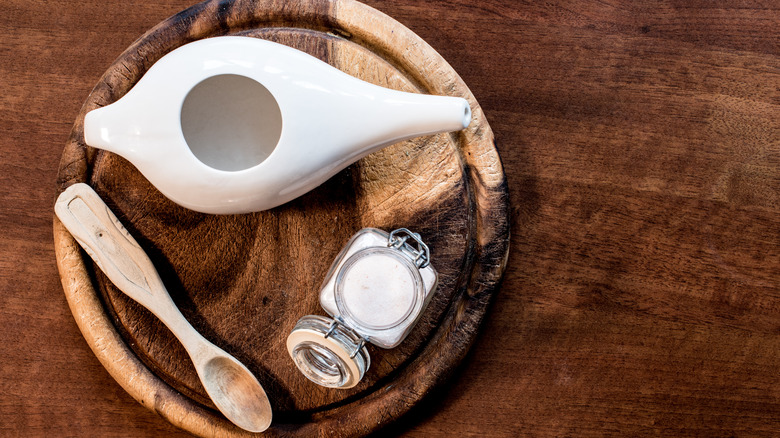The Truth About The Neti Pot
Imagine that you walk into your shared bathroom only to find your roommate (or S/O, it's your vision, so you choose) hunched over the sink with Aladdin's lamp shoved in their nose. As you get closer you realize that they are pouring liquid into one nostril and it is coming out of the other side. Do you ask what they are doing? Or do you tip-toe out of the bathroom, wondering what kind of genie is going to pop out of the nose lamp? Are they gunning to ask for unlimited wishes or for a million dollars? Are they trying to conjure some spirits? What did you just see?
None of the above: They are using a neti pot! Neti pots are a staple tradition of Ayurvedic medicine. They can be used to gently rinse the nasal passage with a saline solution. For many people with hay fever and other sinus issues, neti pots offer huge relief. Many people report that they feel less congested and experience less pain as a result of sinus clogging after enacting a quick saltwater rinse (via WedMD). So rest assured, your housemate may actually be on to something.
How do you use a neti pot?
Once you get past the magic lamp-esque countenance of the neti pot, your first question may be, "How do I use this contraption?" Well, it is surprisingly simple.
Generally, you'll want to use your neti pot near a sink, since saline solution will be dribbling out of your nostril. To begin your nasal cleansing, concoct your saline solution with sterile water and non-iodized salt (via Neti Pot). Once your mixture is ready, tilt your head at a 45-degree angle over your sink, with your eyes facing down towards the basin. Gently press the spout of your pot to one nostril and let the water flow. If you are tilting your head to your left, the spout of your neti pot should be in your right nostril.
Depending on how congested you are, you should feel the sensation of the saline solution traveling through your nasal passages fairly quickly. As you relax and breathe through your mouth, the solution will complete its route and begin to drip out of your opposite nostril. Once the solution has been depleted, you can repeat the process on the other side. It is important to take a short break and breathe evenly through both nostrils between sides (Healthline).
Where did neti pots come from?
If you have never seen a neti pot before you may be a little confused by the unusual vessel. In Sanskrit, "neti" translates to "nasal cleaning," which is exactly what a neti pot is used for (via NeilMed Pharmaceuticals). The neti pot is the oldest method of nasal cleansing and originated in India. Nasal cleansing is one of the six standard cleansing rituals or "kriyas" used by ancient yogis. The other kriyas include cleaning of the eyes, respiratory system and food pipe. The final two kriyas focus on toning the abdominal wall and the intestines (via Flow Yoga Center).
In Ayurvedic yoga tradition, nasal cleansing is done before the physical yoga practice. The idea behind this is that with clean nasal passages, you will be able to breathe clearly. With clear breathing, you will be able to think more clearly. Clear thinking leads to deep meditation, which is what the ancient yogis were all about. They believed that purifying the nose was the first step in overcoming some health issues, addictions, and mood swings (per NeilMed).
Do a lot of people use them?
In some communities, use of the neti pot runs rampant. In other circles, this approach to nasal cleansing is truly esoteric. This raised the question: Do a lot of people actually use neti pots? In 2007, Dr. Oz went on Oprah Winfrey's show and spoke about the benefits of nasal cleansing with a neti pot. Just as you would summon a genie from a bottle, this new info rubbed a lot of people the right way and the neti pot became a popular, holistic form of congestion relief (via NeilMed Pharmaceuticals).
Most commonly, neti pots are used by people with aggressive seasonal allergies and sporadically when cold season rolls around. Some ENT doctors prescribe neti pots or syringe nasal cleansing to their patients after surgery on the nasal passages. With regular flushing, post-op patients can successfully keep crusty funk from building up in their nasal cavities (via WebMD).
Around the world, many people teach their children to use neti pots to encourage good nasal hygiene. So, in short, yes, many people do use neti pots and the popularity of these devices continues to rise.
What do neti pots even do?
Neti pots were created to aid in the cleansing of the nasal passages. While there are not any studies proving any lasting benefits from neti pot use, short-term studies and anecdotal evidence alone make us want to go clean our nostrils right now. Some neti pot users report significant changes in the amount of pressure they feel because of congestion. In addition to decreased facial pressure, avid users claim to have a decrease in headaches and more moisture in the nasal passages (via CNN).
Nasal cleansing works in tandem with the little hairs inside of your nose. These itty-bitty hairs are called "cilia" and they line the inside of your nasal passageways. The cilia do the wave all day, just like your parents at your high school football games. This wave-like motion helps to collect and direct mucus either towards your throat or into the nose to be blown out. By pushing saline solution through the nasal passages, the mucus loosens and the cilia are able to move more freely. Freely moving cilia helps rid your body of allergens and other irritants more efficiently (WebMD).
Does it hurt?
When used with too much enthusiasm — or salt — nasal cleansing can hurt or cause a stinging sensation in the nasal passages. Neither option causes too much pain and both are easily rectified. If you go at it too aggressively, the heavier flow of solution may cause a bit of pressure or stinging throughout your nostrils (via Verywell Health). This can be fixed by simply administering the solution a bit more gently. If there is too much salt in the solution, using your neti pot might cause some stinging throughout your nose, throat, and eyes. This is another issue that can be solved with ease. To fix this, you can also dilute the solution slightly by adding a bit more water.
If the angle of your head isn't quite right, you could end up with a bit of saline solution down your throat. Swallowing a bit of saltwater is not typically painful or dangerous. You might sputter or cough a bit to get reoriented. The sensation is no worse than a bit of drinking water accidentally "going down the wrong pipe." Overall, these mistakes can be sorted out easily after causing only mild discomfort.
What are the benefits?
Neti pots are quite popular among people who want to manage their seasonal allergies and hay fever holistically. Many people with allergies experience irritated sinuses, excess mucus production, and stuffy and runny noses. Nasal cleansing may help alleviate many of those symptoms (via WebMD).
A lukewarm saline solution can help rid your nasal passages of pollen, dust, and other irritants so you can breathe easier. According to "Breath: The New Science of a Lost Art," there may be other benefits, too. Unblocked nasal breathing may lead to a decrease in the fight-or-flight response of your sympathetic nervous system. This response happens when you perceive stress or danger. By limiting our breathing or taking shallow breaths, we activate our nervous systems to respond as if we are experiencing stress. When we slow down and breathe evenly through our noses, we are able to thwart the fight-or-flight response pathway. With this in mind, it makes sense that nasal cleansing is a traditional and foundational step to deep meditation. Saline nasal cleansing is sometimes so effective that people are able to decrease their use of corticosteroid sprays and antibiotics (via Healthline).
Are there drawbacks?
The one overarching con when it comes to using a neti pot is definitely worth mentioning. Many experts express concern about the saline solution wiping out all of the mucus in the sinuses. While too much mucus can cause congestion, nasal mucus contains a lot of immune-supporting elements and beneficial bacteria (via WebMD). The cilia in your nasal passage and the mucus team up as your first line of defense against respiratory illnesses. When used too frequently, nasal cleansing can wash away some very valuable antifungal, antiviral, and antibacterial agents. This ultimately lowers the amount of immune defense that you have.
Experts who have studied the effects of nasal cleansing agree. While washing away beneficial bugs is a concern, they recommend using your neti pot in moderation. Dr. Talal Nsouli. an allergy and asthma immunologist, in particular, recommends using a neti pot for no longer than three weeks (per WebMD).
Are they safe?
According to the FDA, neti pots are typically safe when used correctly. On its own, there is nothing inherently unsafe about nasal cleansing. However, risks arise when they are used improperly.
Most publications, instructions, and experts advise users not to use tap water and table salt in their neti pots. Tap water can contain small amounts of bacteria, protozoa, amebae, and other microorganisms. When these things are swallowed, the potency of stomach acid kills them right away. But since the environment of the sinuses is much gentler and more forgiving, these little bugs can prosper within that space. When given the proper elements in which to thrive, these microorganisms can cause serious infections and in rare cases, death (via FDA).
To avoid such complications, you should first boil tap water. Once it is cool, you can use it in your neti pot. The FDA does caution users to only save the leftover water for 24 hours under refrigeration. Another option is to buy distilled water and use that instead.
How often do you need to clean your neti pot?
Aside from the risk of the occasional brain-eating amoeba, the risks of neti pot use are few and far between. In addition to being cautious about boiling your water or using distilled water, cleanliness is key. Just as we are advised to not share toothbrushes, mascara, and other things that come into contact in our orifices, it is not advisable to share your neti pot with anyone. Even if you wash it thoroughly, there is a chance that could tag along for the ride and infect someone else (via Medical News Today).
Additionally, your risk of infection increases if you do not wash your neti pot properly after each use. "It's just water," you might think, "It is clean." But there's more to the story. The saline solution itself is clean, but any mucus that contains bacteria can grow and multiply if left unwashed. And an unused or seldom-used neti pot could become a vessel for dust and other household grime, which could lead to infection if introduced to the sinus cavities (per Medical News Today).
Can you do it wrong?
If you've ever snorted water up your nose while swimming, you can imagine how uncomfortable it could be if you were to use your neti pot incorrectly. Thankfully, most neti pots come with instructions for use. Plus, we are living in the time of the interwebs — and YouTube has instructional vids for everything, including this ancient Ayurvedic tradition.
Still, it is possible to use your neti pot incorrectly (via The Healthy). If your head is tilted at the wrong angle, you are likely to feel some saline solution run into your throat. With the solution as feedback, you can adjust your angle to ensure the liquid is traveling down the right pathways. Aside from angling your head properly, you'll need to ensure the correct ratio of salt to water. You will need non-iodized salt, as traditional table salt can become an irritant. Once you have the right ratios and angles organized, you are on your way to breathing in the clearest way possible.
Can't you just use ocean water?
No, no, no. You should not use ocean water in your neti pot. Free spirits may tell you that the ocean is the mother healer and while we won't argue that, we do know that there is some funk out at sea. If you don't believe us, just think about fish poop for one minute. This is in addition to the countless other microbial hazards and pollution that pours into the ocean daily. Yes, the ocean is big and diluted and the salt to water ratio may be great. But using ocean water in your neti pot is one way to exponentially increase your risk of developing a potentially fatal infection (via Medical News Today).
Surfers who get tumbled have the chance to develop similar infections because of the microorganisms present in ocean water. In response to this we say: Next time you get stuck in the great Pacific washing machine, make sure you blow air out of your nose. And definitely use distilled water for all of your nasal cleansing porpoises purposes.
Does it really help with allergies?
Neti pots are frequently used by people who suffer from seasonal or even year-round allergies. But do they help? The answer is two-fold. Neti pots can help clear mucus, which is one of the main causes of nasal congestion (via Healthline). In this way, they absolutely do help decrease the symptoms of seasonal allergies. However, neti pots cannot do anything to affect the root cause of allergies. The saltwater may gently bring down a bit of swelling to decrease symptoms, but there is no known mechanism that aids in the control of allergies.
Put another way, flushing with a saline solution can alleviate some of the discomfort associated with allergies, but it won't do anything to change other symptoms of allergies. When used for allergy control, experts still recommend using your neti pot in moderation. Many allergens, such as pollen and dust, can travel into the sinus cavity if there isn't enough mucus lining the nostrils for them to get stuck in. As with all things, it is recommended that you strive for balance. In this case, that is a balance between maintaining some immune system-supporting mucus and cleaning your nostrils to breathe easier (per WebMD).
How many times per week can you use a neti pot?
Studies showing how frequently to use a neti pot are scarce. The body of research does suggest that neti pots should be used in moderation. That said, there is not a clear delineation of just how frequently they should be used (via WebMD). Studies cited by WebMD have shown that as infrequently as three times per week is often enough to have lasting, olfactory benefits. Conversely, using your Neti pot three times per day is ill-advised. This is because you can wash away all of your helpful mucus and leave yourself at a higher risk of contracting an airborne illness or (WebMD).
Within these parameters, the choice is yours — though you should consider consulting your doctor for personalized recommendations. If you feel your best with use every other day, you could work that into your routine. If you only want to rinse your nasal passages once a month, so be it. Once you find the right lil magic lamp to fit your decor and nostrils, you'll be well on your way to clean breathing, courtesy of Ayurvedic traditions.

